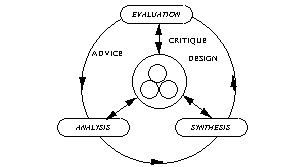2.2 AGENTS OF SYSTEMATIC DESIGN
2.2.3 A TOOL FOR SYSTEMATIC DESIGN
The ASE paradigm is not to be taken too literally, since the actual boundaries between the three stages of design are often blurred. There is a disconnection between some stages of design that would limit the model. The paradigm suggests that synthesis comes from analysis only, or rather from the formalist model - an inductive model of the scientific method - first the observations are made and facts gathered, then the theory is constructed as a generalization of these facts, which as [Dasgupta 89] rephrases for this model, "First accumulate all the requirements that the target system is to satisfy: then synthesize the system to meet the requirements."
The ASE model here is not meant to be administered so severely. Dasgupta argues that there is no room for the "world-view" or experiential nature of design. But the ASE model can still serve as a structure or tool with which to focus concurrent engineering, including the experiential use of design. For purposes of concurrent engineering, there is no overwhelming need to have a distinct separation of the representations of critiques, advice, and design. Agents may have access to them all in direct reference to an artifact-centered approach to design management as opposed to the information flow model.
Figure 9 illustrates the mixing of the agent intermediary representations within a shared, centralized artifact. This allows reference by the agents to a single design and access to mediating representations unavailable with the previous model. For example, the synthesis agent actually can refer to the given state of a design in addition to the design's critiques.
Figure 9 Consolidating and Sharing Agent Results within the ASE Model

Even the availability of all representation and processing results at one stage in the design phase is not enough. There is a memoryless property to the model of Figure 9 similar to a Markov chain, with the next state of a design dependant only on the previous state and independent of the design's past states. While progress toward the final state of design is far from a random walk, there is not the element of control that one would like to see within a model of design.
Research in collaborative design has indicated a necessity for the availability of past states of design, either to reference why certain design decisions were made or to back away from an infeasible design path and start down a new path from some previous design state [Irish & Trigg 89]. Figure 10 illustrates the spiralling nature of design, with the importance of shared memory represented as distinct versions of representations within the larger design artifact. All aspects of design through time, across space, and among various domains are available and built through the spiraling advance of design.
Figure 10 Shared Memory and the Spiraling Advance of ASE Design

Storage of all records throughout design and development allows an evaluation of the social process of creation, as with collaborative text development studies of [Barret 89 B] This persistent, historical recording of design as an artifact and a process is referred to as "shared memory" by [Konda et al 91] and allows the contextual determination of design events to be stored and reviewed. As the significance of social interaction within the design process begins to be understood, the archives of design and process history becomes a resource for an understanding and reconstruction of the process of collaborative, concurrent design.
The ASE model presented here is used as a tool and not the final goal in the study of concurrent engineering design. Despite groundings in a very formal approach, the extended model toward shared memory permits a structure and repository with which to capture, store, and make use of the experiential aspects of design. As a tool, the spiralling ASE model advances the design artifact to its target with each turn.